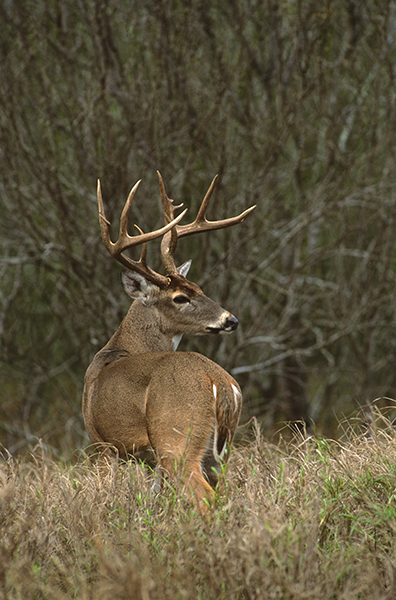How to Grow Giant Whitetails: Unlocking the Power of Minerals

How to Grow Giant Whitetails
One of my most memorable hunts was a bowhunt several years ago, it was actually my first year bowhunting. I was in Southern Iowa in November, a combination in itself that is going to be a good day hunting no matter the outcome. The moment I stepped into the timber, the excitement was unreal. Every little sound—the crunch of leaves, the snap of a twig—had my heart racing. Bow in hand, I eased my way to the stand, moving as quietly as I could. Back then, I didn’t know much about the rut. I was about to find out just how special those first few days of the month could be.
I was sitting there, waiting, I kept scanning the woods, hoping for a good buck to show up. Suddenly, I saw a giant rack of antlers. His antlers stretched high, and I knew right away—he was the one I wanted. As he closed the distance, my adrenaline kicked into overdrive. At 30 yards, I drew back, my heart hammering in my chest. I took a deep breath and let the arrow fly. With deductions, the buck ended up netting 177 1/8 inches of antler. From that point on, I was hooked and determined to do everything I could to get another chance at a Boone & Crockett class buck.
Growing Trophy-Class Deer
If you’re serious about learning how to grow giant whitetails, then you know genetics will only take you so far. If you really want to see trophy-class whitetails on your land, you’ve got to give them the right nutrients to reach their full potential. I’ve spent years managing deer herds, and I can tell you firsthand that getting the right minerals and supplemental feed out there in the spring makes all the difference. Antler growth depends on what those bucks are putting into their bodies, and if they don’t have the right minerals and protein, they’re going to be limited in what they can produce.
Every year, as the weather warms up, I shift my focus to supplemental feeding and making sure my deer have everything they need to be at their healthiest. There are a few different ways to go about it—food plots, mineral sites, and supplemental feed stations. You’ve got to have a strategy, though, because just tossing out a bag of feed now and then isn’t going to cut it.
One of the most important things I focus on is getting the right minerals out there. A buck’s antlers are nearly half minerals when they’re fully developed, and the big ones don’t get that way by accident. Calcium and phosphorus are absolutely essential since they’re the backbone of strong antlers. Magnesium plays a role too, keeping those racks solid and durable. Trace minerals like zinc and copper help with overall health, which means better immune systems and stronger, healthier deer. And let’s not forget sodium and potassium—those are key for hydration and overall body function, especially in the heat of summer.
Give Deer Access To Minerals and Supplemental Feed
There are a couple of ways to make sure your deer are getting those minerals. You can put out mineral licks, either loose or in block form, or you can go for liquid mineral supplements in their water sources. I’ve had good luck with both, but I always make sure to keep them refreshed and easily accessible. A lot of guys use cattle mineral blocks from the local co-op, and while those can work, I always compare labels to make sure they’ve got the right balance of nutrients for deer.
Of course, minerals are just one piece of the puzzle. If you want your deer to grow, they need protein—lots of it. Spring and summer are when those racks are developing, and a high-protein diet is a game-changer. That’s why I plant food plots with plenty of clover and alfalfa. Clover is an easy go-to because it’s packed with protein and stays palatable for a long time. Alfalfa is another powerhouse, but you’ve got to keep it mowed to prevent it from getting too tough and stalky. I’ve watched deer hit alfalfa even when it’s brown, so it’s definitely worth having in the mix.
Soybeans are another great option if you’ve got the land for them. They’re high in protein and keep deer coming back all season long. And if you’re supplementing with commercial feed, make sure it’s got at least 16-20% protein to really support antler growth. Pelleted protein feed can be a great addition, especially in areas where natural food sources might be lacking.
Don’t Forget Water
While food and minerals are the foundation, water is just as important. A healthy deer herd needs clean, fresh water, and that means avoiding stagnant pools where disease-carrying insects can breed. EHD and CWD have hit hard in some areas, and the last thing you want is for your herd to suffer because they’re drinking from stagnate sources which can be a breeding ground for biting midges spreading EHD. I always try to keep water stations in well-drained areas away from mud and stagnant water. If you can manage it, small artificial ponds can work wonders.
Final Reminders
You can also leverage water to add additives to attract deer. You just want to be mindful of current hunting rules and regulations when the hunting season approaches. Water additives can be classified under the current Iowa definition of “baiting”. You want to make sure you’re following the rules.
One thing to be mindful of when setting up supplemental feeding and mineral sites is disease prevention. You don’t want your deer eating where they’re defecating, so rotating feeding sites is a must. I always spread out my feeding stations and change locations regularly to keep things clean and minimize disease risks.
Before you start putting out minerals or feed, check your local laws. Some states have strict baiting regulations, especially during hunting season. You don’t want to invest time and effort into setting up feeding sites only to find out you’re in violation of local game laws. Knowing the rules will keep you out of trouble and ensure you’re managing your deer the right way.
At the end of the day, growing trophy whitetails isn’t just about hoping for good genetics—it’s about putting in the work to make sure they have everything they need to reach their potential. Providing the right minerals, supplementing with high-protein food sources, keeping clean water available, and managing feeding areas properly all contribute to a stronger, healthier herd. If you do it right, you’ll not only see bigger racks, but you’ll also have a thriving deer population that keeps improving year after year.
By Aaron McKinney
Home – Iowa Sportsman
April 2025
Check out Last month’s issue of Whitetails 365
Also check out another article from this months issue of the Iowa Sportsman
Also here are our other websites take a look, especially if you have any interest in cattle.

